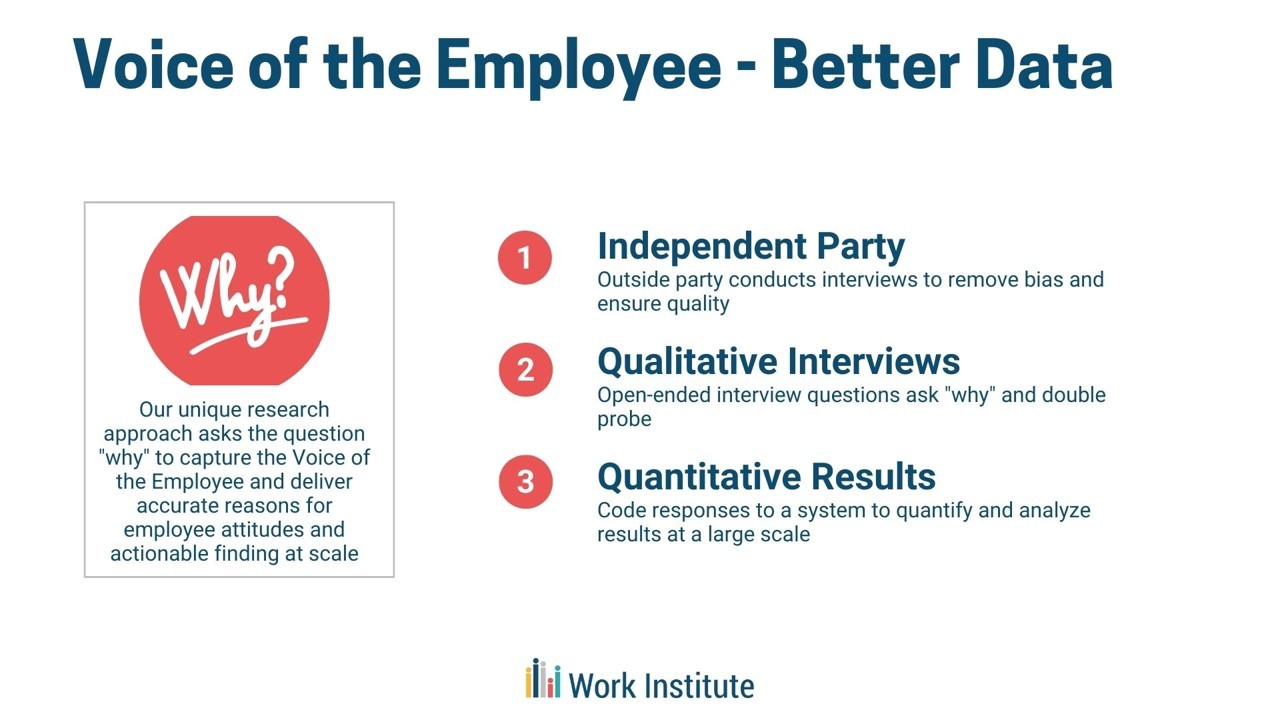Updated: February 29, 2024
Voice of the employee has become increasingly important to leaders of organizations, leading the Society for Industrial and Organizational Psychology to list capturing the employee voice as the number seven workplace trend. As the emphasis escalates, many human resources leaders may be asking what is the definition of voice of employee and why is voice of employee important?
Below, we will define the employee voice and outline a few key benefits. Additionally if you feel that your company could do a better job at capturing employee voice, or would like professional assistance doing so, you can always reach out to our team for an initial consultation from our workforce experts.
Defining Employee Voice of the “Voice of the Employee”
Voice of employee is defined as the opportunity for employees to express concerns about policies in the workplace and offer ideas about how to improve conditions in the workplace. Within the concept of employee voice, there are two types: formal and informal. Informal employee voice is defined as the ability for employees to provide feedback and discuss concerns on a daily basis. Formal employee voice is defined as structured communication channels provided by the employer, including systems to file grievances and employee surveys. Formal voice of employee, specifically voice of the employee surveys, are the focus of this information.
Asking employees for feedback through formal employee studies and surveys is a way to give employees a voice. However, it’s critical that the voice of employees has an actual impact and real influence on the organization. To effectively give employees a voice, organizations must meet three criteria:
- Provide structured channels for feedback in the form of surveys
- Create a culture of acceptance for feedback
- Demonstrate that the feedback influences organizational changes and improvements.
The Importance of the Voice of the Employee
The importance placed upon capturing voice of employee has increased as organizations realize that there are multiple benefits associated with it, such as a boost in employee retention and engagement. Below are a few key benefits of capturing the voice of employees.
Increased Retention
The primary outcome impacted by capturing voice of employee is employee retention, or conversely a reduction in turnover, as it’s proven that the number of ways employees have to use their voice impacts employee retention. This fact has propelled organizations to increase the number of ways available for employees to provide feedback.
Increased Engagement
Increased employee engagement is a benefit of capturing employee voice. It’s critical to give employees a voice at various stages of employment, and ask for feedback, to improve organizational policies. Employees, when asked in an effective manner, provide feedback on what they like, what they don’t like and what can be improved in the workplace at various stages, which leads to improved engagement and retention.
Improved Job Satisfaction
Improved job satisfaction is another benefit of capturing employee voice. Higher levels of job satisfaction among employees has been reported when employees have regular meetings with supervisors and when employees become more involved in the organization. Additionally, employee participation in decision making leads to improved job satisfaction.
Higher Performance Ratings
Managers rate employee performance higher when the employee demonstrates a high-level of employee voice. Conversely, managers rate employee performance lower when the employee demonstrated a lower-level of employee voice. The direct link between manager performance ratings and use of employee voice demonstrates that employees who use their voice are valued and that using employee voice is viewed as an important aspect of performance.
Get Help Capturing Employee Voice at Your Company
As we look to start a new year, place capturing the voice of employees at the top of your list of strategic priorities. Then, ensure you deliver the 3 criteria for effectively giving employees a voice and you will realize the key benefits and more. If your interested in gauging the voice of the employees at your organization through staff surveys and studies, contact us today and speak with one of our workforce experts here at Work Institute.
Article References:
- Society for Industrial and Organizational Psychology. (2016). Top 10 workplace trends 2017. Retrieved from http://www.siop.org/article_view.aspx?article=1610
- Farndale, E., Van Ruiten, J., Kelliher, C., & Hope-Hailey, V. (2011). The influence of perceived employee voice on organizational commitment: An exchange perspective. Human Resource Management, 50, 113-129. doi: 10.1002/hrm.20404
- Fynes, J. M. (2017). The Importance of Employee Voice Across Employment Stages. Workplace Insights, 5(1).
- Klaas, B. S, Olson-Buchanan, J. B., & Ward, A. K. (2012). The determinants of alternative forms of workplace voice: An integrative perspective. Journal of Management, 38, 314-345. doi: 10.1177/0149206311423823
- Farndale, E., Van Ruiten, J., Kelliher, C., & Hope-Hailey, V. (2011). The influence of perceived employee voice on organizational commitment: An exchange perspective. Human Resource Management, 50, 113-129. doi: 10.1002/hrm.20404
- Spencer, D. G. (1986). Employee voice and employee retention. Academy of Management Journal, 29, 488-502. doi: 10.2307/256220
- Holland, P., Pyman, A., Cooper, B. K., & Teicher, J. (2011). Employee voice and job satisfaction in Australia: The centrality of direct voice. Human Resource Management, 50, 95-111. doi: 10.1002/hrm.20406
- Goñi-Legaz, S., & Ollo-López, A. (2017). Temporary contracts, participation in decision making and job satisfaction in European workers: Is there a buffering effect?. International Journal of Manpower, 38, 875-892, doi: 10.1108/IJM-04-2016-0086
- Whiting, S. W., Podsakoff, P. M., & Pierce, J. R. (2008). Effects of task performance, helping, voice, and organizational loyalty on performance appraisal ratings. Journal of Applied Psychology, 93, 125-139. doi: 10.1037/0021-9010.93.1.125
- Burris, E. R., Detert, J. R., & Romney, A. C. (2013). Speaking up vs being heard: The disagreement around and outcomes of employee voice. Organization Science, 24, 22-38. doi: 10.1287/orsc.1110.0732


